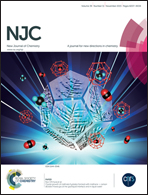Improved electrochemical properties of (1 − x)LiFePO4·xLi3V2(PO4)3/C composites prepared by a novel sol–gel method
Abstract
In this study, (1 − x)LiFePO4·xLi3V2(PO4)3/C (x = 0, 0.1, 0.2, 0.3, 0.4, 0.5 and 1) composite cathode materials are synthesized using CH3COOLi·2H2O, Fe(CH3COO)2·4H2O, V2O5, and H3PO4 as starting materials with N,N-dimethyl formamide as a dispersing agent using a novel sol–gel method. The structure, morphology, and electrochemical properties of the composites are characterized by X-ray diffraction (XRD), transmission electron microscopy (TEM), X-ray photoelectron spectroscopy (XPS), cyclic voltammetry (CV), electrochemical impedance spectroscopy (EIS), and charge–discharge measurements. XRD patterns of the compound indicate the coexistence of LiFePO4 and Li3V2(PO4)3. Compared to pristine LiFePO4 and Li3V2(PO4)3, the composite materials exhibit smaller particle size, which can facilitate Li+ extraction and insertion, thereby leading to an improvement in the electrochemical properties. Among all the composites synthesized, 0.8LiFePO4·0.2Li3V2(PO4)3/C exhibits the best electrochemical performance with an initial specific discharge capacity of 158.7 mA h g−1 at 0.1C in the voltage range of 2.5–4.3 V. When the current rate is increased to 5C and 10C, the capacity of 0.8LiFePO4·0.2Li3V2(PO4)3/C is retained at 125.8 and 110.8 mA h g−1, respectively, indicating the cycling stability of the composite.


 Please wait while we load your content...
Please wait while we load your content...